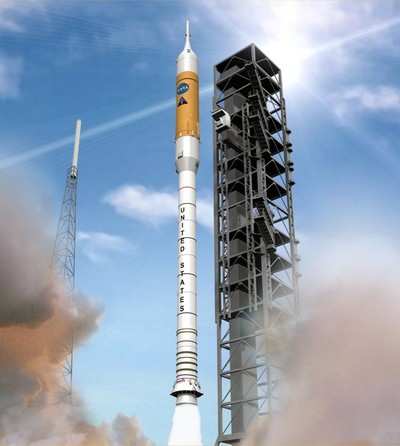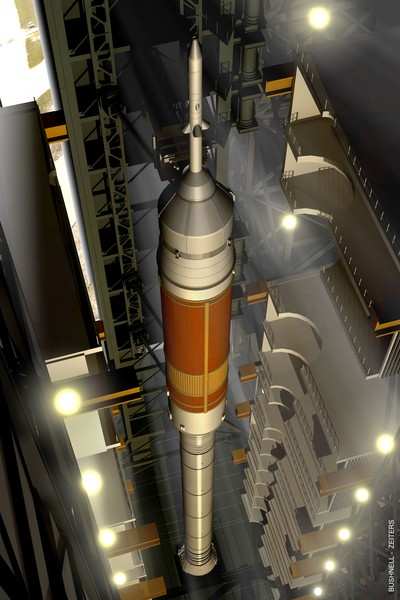NASA Says New Problem Will Be Solved, Too
NASA's Constellation program, which is a collection of
technologies intended to replace the US Space Shuttle as America's
primary way into space, is up against a number of serious technical
challenges. The Ares I rocket, in particular, has acknowledged
problems with adequate lift capability and vibration.

Now, The Orlando Sentinel cites anonymous sources in reporting
that a tendency by the solid-fuel rocket to drift laterally
immediately after ignition poses a risk of damage to -- or even a
collision with -- the launch tower.
The Sentinel says it reviewed more than 800 pages of NASA
documents and interviewed more than a dozen engineers, technicians
and NASA officials involved with the project. Most would only speak
anonymously, saying they feared retribution from NASA
management.
The latest technical problem to plague Ares is termed "liftoff
drift," which is exactly what it sounds like. When solid-fuel
rockets ignite, the sudden explosion of thrust causes the launch
vehicle to shift position on the launchpad during liftoff, whereas
the comparatively more gradual ignition of liquid-fueled rockets
lessens that tendency. The Ares I first stage uses solid-fuel
rocket boosters similar to those on the shuttle.
Compounding the issue for Ares would be liftoff in winds blowing
greater than 12.7 mph from the southeast... which many engineers
say would be enough to push the narrow rocket into the launch
gantry.
"We were told by a person directly involved [in looking at the
problem] that as they incorporate more variables into the
liftoff-drift-curve model, the worse the curve becomes," said one
anonymous NASA contractor to the paper. "I get the impression that
things are quickly going from bad to worse to unrecoverable."
Predictably, NASA officials downplay the latest fears. They've
become used to the routine, too... as over the past two
years the agency has received substantial criticism from the
scientific community, including former astronauts, concerning a
number of issues with the Ares.

As ANN reported, complaints surfaced in late
2006 concerning a shortage of liftoff thrust, which NASA said were
overblown. In January 2008, NASA admitted the Ares design also
suffered the potential for severe "thrust oscillation"
during liftoff -- another less-than desirable trait of
solid-rocket boosters. In August, NASA said it had sufficiently
addressed the problem... through the use of 17 remote-controlled
vibration dampeners, each with 100-lb weights attached to springs
able to be moved up and down as needed to counteract such
vibrations.
As for the liftoff drift issue, Constellation program manager
Jeff Hanley says NASA will solve that problem, too. "There are
always issues that crop up when you are developing a new rocket and
many opinions about how to deal with them. We have a lot of data
and understanding of what it's going to take to build this."
One idea NASA suggested would be to reposition or redesign the
launchpad. But some internal sources say the real problem will be
hitting timetables and budget benchmarks set for the Constellation
program... especially if the incoming US president decides Ares
(and the Constellation moon program as a whole) simply isn't worth
the billions of dollars spent so far, nevermind the significant
costs that lie ahead.

NASA's case in that forthcoming political battle isn't helped by
the number of engineers who damn the Ares I as a potentially
dangerous, or deadly, pipe dream. Last month, award-winning NASA
engineer Jeff Finckenor quit the Ares program in apparent
disgust.
"It's time for a rethink," said Finckenor, in his farewell
letter to colleagues obtained without his permission by agency
watchdog NASAWatch.com. "At the highest levels of the agency, there
seems to be a belief that you can mandate reality, followed by a
refusal to accept any information that runs counter to that
mandate."
Most believe if NASA is given enough time and money, it will
eventually sort out the problems with Ares. "If they push hard
enough, yes, it will fly," said one program engineer. "But there
are going to be so many compromises to be able to launch it, and it
will be so expensive and so behind schedule, that it may be better
if didn't fly at all."
That sentiment is reflected in the results of
last month's preliminary design review of the Ares
program, which NASA touted as a positive step forward
for the program.
Well... perhaps not so much. Ares did pass the review... but
with a cumulative score of a 2.1, or a very low "C." In fact, out
of the 10 criteria NASA held Ares to, the rocket scored equivalents
of Cs and Ds in seven of them.
Former NASA astronaut and International Space Station commander
Leroy Chiao says many of his friends at NASA are infuriated by the
agency's stubborn push forward with Ares."I would say that I have
heard various concerns," said Chiao, who retired from NASA in 2005.
"If I were still in the corps, I'd be skeptical about when is this
thing going to fly and will we be able to put all the fixes in
place."
Several engineers and astronauts have proposed NASA scrap Ares,
in favor of the proven Atlas V rocket... or even the so-called
"Direct 2.0" launch vehicle, originally designed in the aftermath
of the 1986 Challenger explosion.

Alas, it may prove impossible to change NASA's direction for
Ares... since the program is the brainchild of current agency
administrator Michael Griffin (shown above, center) who proposed a
rocket design very similar to Ares when he was the head of the
Space Department at Johns Hopkins University's Applied Physics
Laboratory.
 ANN's Daily Aero-Term (04.14.24): Maximum Authorized Altitude
ANN's Daily Aero-Term (04.14.24): Maximum Authorized Altitude ANN's Daily Aero-Linx (04.14.24)
ANN's Daily Aero-Linx (04.14.24) Classic Aero-TV: 'We're Surviving'-- Kyle Franklin Describes Airshow Life 2013
Classic Aero-TV: 'We're Surviving'-- Kyle Franklin Describes Airshow Life 2013 Aero-News: Quote of the Day (04.14.24)
Aero-News: Quote of the Day (04.14.24) Airborne 04.09.24: SnF24!, Piper-DeltaHawk!, Fisher Update, Junkers
Airborne 04.09.24: SnF24!, Piper-DeltaHawk!, Fisher Update, Junkers






